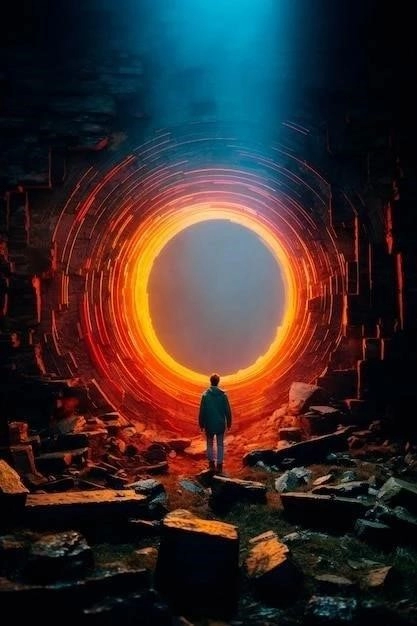Our universe is a vast and enigmatic expanse‚ filled with celestial wonders that have captivated humanity for millennia. As we peer deeper into the cosmos‚ we encounter mysteries that challenge our understanding of the fundamental laws of physics. One such enigma is the elusive presence of dark matter‚ an invisible substance that pervades the universe‚ leaving its ghostly fingerprint on the cosmic tapestry.

The Cosmic Ballet and the Missing Mass
The story of dark matter begins with the graceful dance of celestial objects. Astronomers‚ observing the rotational velocities of galaxies‚ noticed something peculiar. The stars at the edges of spiral galaxies were moving far too quickly‚ defying the predictions of Newtonian gravity. If the visible matter‚ such as stars and gas‚ constituted the entirety of a galaxys mass‚ these outer stars should have been flung out into the void due to their high speeds. Clearly‚ there was an unseen hand orchestrating this cosmic ballet‚ an invisible mass holding these galaxies together.
Further evidence for this missing mass emerged from the study of galaxy clusters. These massive congregations of galaxies exhibited gravitational effects that far exceeded the mass accounted for by their visible components. The galaxies within these clusters moved at astonishing speeds‚ held together by a gravitational force far greater than what could be explained by the luminous matter alone. It was as if an invisible glue was binding these galaxies together‚ preventing them from flying apart.
Enter Dark Matter: The Invisible Architect
To reconcile these puzzling observations with our understanding of gravity‚ scientists proposed the existence of dark matter‚ a mysterious substance that does not interact with light‚ making it invisible to our telescopes. This elusive matter was thought to make up the missing mass‚ providing the gravitational scaffolding upon which galaxies and galaxy clusters were built.
But what exactly is dark matter? Despite decades of intensive research‚ its true nature remains one of the most profound mysteries in modern astrophysics. We know that it is not composed of the ordinary matter that makes up stars‚ planets‚ and ourselves. This “baryonic” matter interacts with light‚ making it visible to us. Dark matter‚ however‚ interacts with ordinary matter only through its gravitational pull‚ leaving scientists to devise ingenious methods to detect its presence indirectly.
Gravitational Lensing: A Cosmic Magnifying Glass
One of the most compelling pieces of evidence for dark matter comes from the phenomenon of gravitational lensing. According to Einsteins theory of general relativity‚ massive objects‚ such as galaxy clusters‚ can bend the fabric of spacetime. This bending acts like a cosmic magnifying glass‚ distorting and amplifying the light from distant galaxies located behind the massive object.
By studying the distorted images of these background galaxies‚ astronomers can map the distribution of mass within the intervening galaxy cluster. The observed lensing effects are far greater than what can be explained by the visible matter alone‚ providing strong evidence for the presence of dark matter in these clusters.
The Cosmic Microwave Background: Echoes from the Early Universe
Further clues about dark matter come from the cosmic microwave background (CMB)‚ the faint afterglow of the Big Bang. This ancient radiation‚ which permeates the entire universe‚ carries with it the imprint of the early universe‚ providing a snapshot of the cosmos just 380‚000 years after the Big Bang.
Tiny fluctuations in the temperature and polarization of the CMB reveal the seeds of the large-scale structures we observe in the universe today; The pattern of these fluctuations suggests that the early universe was composed of about 85% dark matter and 15% ordinary matter. This ratio has held remarkably constant over cosmic time‚ shaping the evolution of galaxies and galaxy clusters.

The Candidates: A Cosmic Whodunnit
Despite its elusive nature‚ scientists have not been deterred in their quest to unveil the identity of dark matter. Over the years‚ several candidates have emerged‚ each with its own strengths and weaknesses:
1. Weakly Interacting Massive Particles (WIMPs)
For a long time‚ WIMPs have been considered the leading candidate for dark matter. These hypothetical particles are thought to be heavy‚ slow-moving‚ and interact with ordinary matter only through the weak force and gravity. However‚ despite numerous experiments designed to detect WIMPs‚ they have so far evaded detection‚ casting doubt on their existence.
2. Axions
Axions are another hypothetical particle that could potentially make up dark matter. Unlike WIMPs‚ axions are extremely light and interact even more weakly with ordinary matter. While their existence is yet to be confirmed‚ experiments are underway to search for their subtle signatures.
3. Sterile Neutrinos
Neutrinos are subatomic particles that interact very weakly with ordinary matter; While the known types of neutrinos are too light to be dark matter‚ some theories propose the existence of “sterile” neutrinos‚ which interact even more weakly and could potentially account for the missing mass.
4. Primordial Black Holes
Another intriguing possibility is that dark matter is composed of primordial black holes‚ black holes that formed in the very early universe. These ancient objects could have a wide range of masses‚ potentially explaining the observed gravitational effects attributed to dark matter.

The Quest Continues: Unveiling the Invisible
The mystery of dark matter continues to captivate and challenge astronomers and physicists alike. While its true nature remains elusive‚ the quest to understand this invisible component of our universe has led to groundbreaking discoveries and pushed the boundaries of our knowledge.
As technology advances and new experiments come online‚ we move closer to unraveling the secrets of dark matter. The discovery of its true identity would be a monumental achievement‚ revolutionizing our understanding of the universe and its evolution. Until then‚ dark matter remains one of the most profound and intriguing mysteries in modern science‚ a testament to the vastness and wonder of the cosmos.
Beyond Particle Physics: Exploring Alternative Theories
While the search for dark matter particles has dominated the field‚ some researchers are exploring alternative explanations for the observed gravitational anomalies. These theories challenge the standard model of cosmology and propose modifications to our understanding of gravity itself.
1. Modified Newtonian Dynamics (MOND)
MOND posits that Newtons laws of gravity deviate from their classical behavior at extremely low accelerations‚ such as those found in the outer regions of galaxies. By modifying the gravitational force law‚ MOND can explain the observed rotation curves of galaxies without invoking dark matter. However‚ MOND faces challenges in explaining other cosmological observations‚ such as the behavior of galaxy clusters and the cosmic microwave background.
2. Tensor-Vector-Scalar Gravity (TeVeS)
TeVeS is a relativistic generalization of MOND that attempts to address some of its shortcomings. It introduces additional fields into the theory of gravity‚ modifying its behavior at both galactic and cosmological scales. While TeVeS has shown some promise‚ it remains a highly complex and speculative theory.
3. f(R) Gravity
f(R) gravity theories modify Einsteins general relativity by replacing the Ricci scalar (R)‚ a measure of the curvature of spacetime‚ with a more general function of R. This modification can lead to accelerated expansion of the universe without the need for dark energy‚ another mysterious component of the cosmos. However‚ f(R) gravity models also face challenges in matching all cosmological observations.
The Importance of Continued Exploration
The quest to understand dark matter and the nature of gravity is a testament to the scientific spirit of inquiry. Whether through the detection of new particles or the development of revolutionary theories‚ the pursuit of this cosmic enigma will undoubtedly lead to profound insights into the workings of our universe. Continued exploration‚ both observational and theoretical‚ is crucial to unraveling the hidden secrets of dark matter and its role in shaping the cosmos we observe today.










